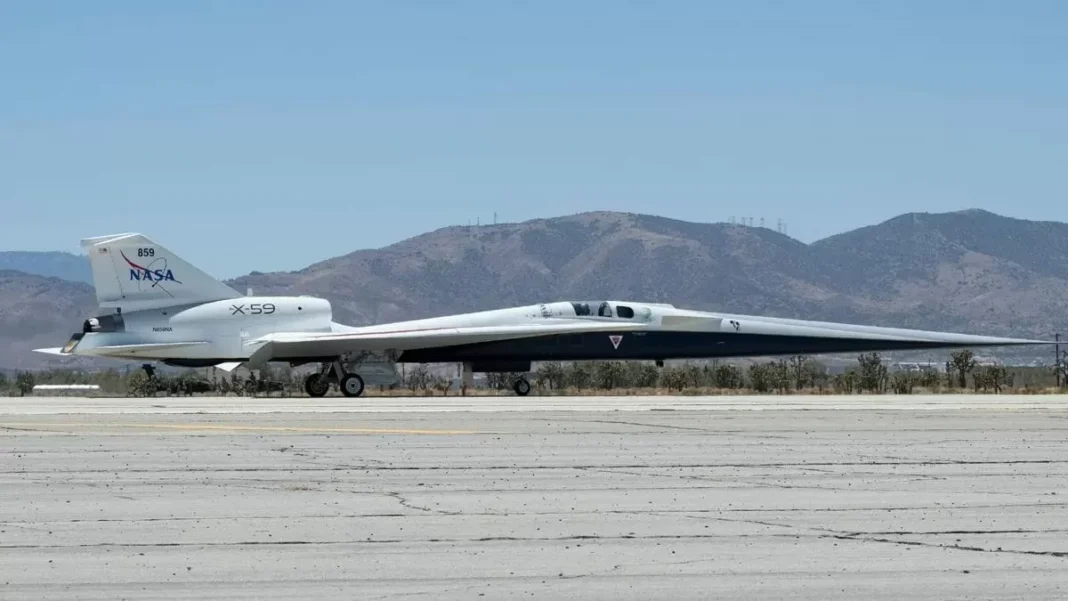NASA and Lockheed Martin’s X-59 Experimental Aircraft Takes Flight at U.S. Air Force Plant 42
NASA and Lockheed Martin’s highly anticipated X-59 experimental aircraft is making its mark at the U.S. Air Force’s Plant 42, located in Palmdale, California. The X-59 is a groundbreaking aircraft designed for quiet supersonic travel, and it is currently undergoing taxi tests at the renowned aerospace facility.
The X-59 is a joint project between NASA and Lockheed Martin, with the goal of developing a supersonic aircraft that can fly at speeds of Mach 1 without creating a loud sonic boom. This technology has the potential to revolutionize air travel, making it faster, more efficient, and more environmentally friendly.
One of the most unique features of the X-59 is its AR-enabled camera vision system, which allows the pilot to see the ground in front of the aircraft in real-time. This advanced technology provides the pilot with a clear view of the runway during takeoff and landing, making it easier and safer to control the aircraft. This is especially important for the X-59, as it has a unique shape that reduces the size of the sonic boom.
The X-59’s shape is designed to minimize the sonic boom, which is created when an aircraft breaks the sound barrier. This is achieved through careful engineering and design, with the goal of reducing the noise level of the sonic boom to that of a car door closing. This breakthrough technology has the potential to make supersonic travel a reality for commercial flights, without causing disturbance to those on the ground.
The X-59 is the latest in a long line of groundbreaking aerospace programs at Plant 42. The facility has been a hub for innovation and technological advancements since it was established in 1956. It has been home to iconic programs such as the F-22 Raptor and the assembly of the Space Shuttle.
The X-59’s presence at Plant 42 continues NASA’s legacy of pushing the boundaries of aerospace technology. The facility’s state-of-the-art infrastructure and highly skilled workforce have made it the ideal location for the development of this revolutionary aircraft. The partnership between NASA and Lockheed Martin has also been crucial in the success of the X-59 project, with both organizations bringing their expertise and resources to the table.
The X-59’s taxi tests at Plant 42 mark a significant milestone in the aircraft’s development. These tests will allow the team to evaluate the aircraft’s performance on the ground, ensuring that it is ready for its first flight in 2022. The X-59’s first flight will be a historic moment, as it will be the first supersonic flight over land in almost 20 years.
The X-59 project is not just about developing a supersonic aircraft; it is also about paving the way for future advancements in aviation. The technology and knowledge gained from this project will be invaluable in the development of more sustainable and efficient aircraft in the future. It is a testament to NASA’s commitment to pushing the boundaries of what is possible in the world of aviation.
In conclusion, the X-59 experimental aircraft is a game-changer in the world of supersonic travel. Its advanced technology, including the AR-enabled camera vision system and boom-reducing shape, has the potential to revolutionize air travel and make it more accessible and environmentally friendly. The X-59’s presence at Plant 42 is a testament to the facility’s reputation as a center for innovation and NASA’s legacy of pushing the boundaries of aerospace technology. We eagerly await the X-59’s first flight and the exciting possibilities it holds for the future of air travel.



